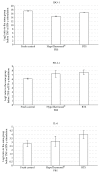Clinically Relevant Solution for the Hypothermic Storage and Transportation of Human Multipotent Mesenchymal Stromal Cells
- PMID: 30805009
- PMCID: PMC6360551
- DOI: 10.1155/2019/5909524
Clinically Relevant Solution for the Hypothermic Storage and Transportation of Human Multipotent Mesenchymal Stromal Cells
Abstract
The wide use of human multipotent mesenchymal stromal cells (MSCs) in clinical trials requires a full-scale safety and identity evaluation of the cellular product and subsequent transportation between research/medical centres. This necessitates the prolonged hypothermic storage of cells prior to application. The development of new, nontoxic, and efficient media, providing high viability and well-preserved therapeutic properties of MSCs during hypothermic storage, is highly relevant for a successful clinical outcome. In this study, a simple and effective trehalose-based solution was developed for the hypothermic storage of human bone marrow MSC suspensions for further clinical applications. Human bone marrow MSCs were stored at 4°C for 24, 48, and 72 hrs in the developed buffered trehalose solution and compared to several research and clinical grade media: Plasma-Lyte® 148, HypoThermosol® FRS, and Ringer's solution. After the storage, the preservation of viability, identity, and therapeutically associated properties of MSCs were assessed. The hypothermic storage of MSCs in the new buffered trehalose solution provided significantly higher MSC recovery rates and ability of cells for attachment and further proliferation, compared to Plasma-Lyte® 148 and Ringer's solution, and was comparable to research-grade HypoThermosol® FRS. There were no differences in the immunophenotype, osteogenic, and adipogenic differentiation and the immunomodulatory properties of MSCs after 72 hrs of cold storage in these solutions. The obtained results together with the confirmed therapeutic properties of trehalose previously described provide sufficient evidence that the developed trehalose medium can be applied as a low-cost and efficient solution for the hypothermic storage of MSC suspensions, with a high potential for translation into clinical practice.
Figures





Similar articles
-
Evaluation of bone marrow-derived mesenchymal stem cells after cryopreservation and hypothermic storage in clinically safe medium.Tissue Eng Part C Methods. 2012 Jun;18(6):453-63. doi: 10.1089/ten.TEC.2011.0395. Epub 2012 Feb 2. Tissue Eng Part C Methods. 2012. PMID: 22196031
-
A pair of cell preservation solutions for therapy with human adipose tissue-derived mesenchymal stromal cells.Regen Ther. 2020 Jan 16;14:95-102. doi: 10.1016/j.reth.2019.10.004. eCollection 2020 Jun. Regen Ther. 2020. PMID: 31988999 Free PMC article.
-
Reconstitution and post-thaw storage of cryopreserved human mesenchymal stromal cells: Pitfalls and optimizations for clinically compatible formulants.Regen Ther. 2023 Apr 20;23:67-75. doi: 10.1016/j.reth.2023.03.006. eCollection 2023 Jun. Regen Ther. 2023. PMID: 37153832 Free PMC article.
-
Trehalose Cryopreservation of Human Mesenchymal Stem Cells from Cord Tissue.Biopreserv Biobank. 2024 Dec 26. doi: 10.1089/bio.2024.0025. Online ahead of print. Biopreserv Biobank. 2024. PMID: 39723442
-
Response to Intravenous Allogeneic Equine Cord Blood-Derived Mesenchymal Stromal Cells Administered from Chilled or Frozen State in Serum and Protein-Free Media.Front Vet Sci. 2016 Jul 22;3:56. doi: 10.3389/fvets.2016.00056. eCollection 2016. Front Vet Sci. 2016. PMID: 27500136 Free PMC article.
Cited by
-
The New Serum-Free OptiPASS® Medium in Cold and Oxygen-Free Conditions: An Innovative Conservation Method for the Preservation of MDA-MB-231 Triple Negative Breast Cancer Spheroids.Cancers (Basel). 2021 Apr 18;13(8):1945. doi: 10.3390/cancers13081945. Cancers (Basel). 2021. PMID: 33919619 Free PMC article.
-
Schisandrin B Improves the Hypothermic Preservation of Celsior Solution in Human Umbilical Cord Mesenchymal Stem Cells.Tissue Eng Regen Med. 2023 Jun;20(3):447-459. doi: 10.1007/s13770-023-00531-2. Epub 2023 Mar 22. Tissue Eng Regen Med. 2023. PMID: 36947320 Free PMC article.
-
Clinically relevant preservation conditions for mesenchymal stem/stromal cells derived from perinatal and adult tissue sources.J Cell Mol Med. 2021 Nov;25(22):10747-10760. doi: 10.1111/jcmm.17016. Epub 2021 Oct 27. J Cell Mol Med. 2021. PMID: 34708529 Free PMC article.
-
Influence of Hypothermic Storage Fluids on Mesenchymal Stem Cell Stability: A Comprehensive Review and Personal Experience.Cells. 2021 Apr 28;10(5):1043. doi: 10.3390/cells10051043. Cells. 2021. PMID: 33925059 Free PMC article. Review.
-
Key quality parameter comparison of mesenchymal stem cell product cryopreserved in different cryopreservation solutions for clinical applications.Front Bioeng Biotechnol. 2024 Aug 1;12:1412811. doi: 10.3389/fbioe.2024.1412811. eCollection 2024. Front Bioeng Biotechnol. 2024. PMID: 39148941 Free PMC article.
References
LinkOut - more resources
Full Text Sources

